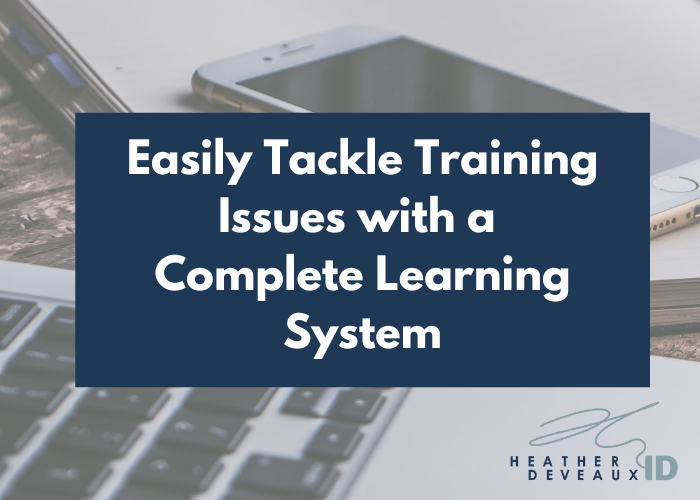Tackle Training Issues With a Complete Learning System
Creating a complete learning system doesn’t have to be complicated, but it sure does feel that way.
Organizations often face several challenges when it comes to learning and development. For starters, it’s difficult to keep up with the demands of an ever-changing market and ensure that learners are getting what they need to succeed. Rather than take a reaction approach to training and development, taking a step back to design and implement a complete learning system might be right for you.
A complete learning system can not only address massive pain points effectively, but it can help you leverage existing systems and processes for better results.
Fragmented Training Programs
If your training schedule is haphazard at best, you might be frustrated with the time and effort it takes to implement a new training program. Whether you work in non-profit or corporate settings, designing and developing training takes time. If you let things pile up, it can lead to more frustration than ever before.
What can you do to create more cohesive learning patterns?
When you choose to implement a full-scale learning ecosystem and implement end-to-end solutions, you’re giving yourself the time and space to make decisions ahead of time. Rather than playing catch up, you can have a full plan of action for your organization, your learners, customers, and employees.
Integrating various learning opportunities in a variety of ways means that learning never gets boring. It creates an environment for success, and you always have a comprehensive collection of materials, opportunities and activities to pull from.

Engagement and Motivation Issues
I’m not going to pretend it’s easy to get learners engaged. It’s a massive complaint of my clients and we tackle this issue on a case-by-case basis. Creating a learning system is not enough. It has to be designed to ensure that learners enter the environment ready to learn and feel they are being rewarded as they move through the system. Calling it a system doesn’t make it sound very fun, to be honest, but that’s what it is: a complete learning system.
How can you improve engagement and motivation with a complete learning system?
You can overcome these challenges by anticipating them. An experienced instructional designer can help you identify the gaps and make plans to touch base with learners along the way. Integrated diverse learning solutions and personalized paths mean training is more engaging and relevant.
Difficulty Tracking Progress
Another major complaint my clients have is the lack of reporting features their current systems have. It can be tricky to nail down what data a training organization needs to collect and leverage, but with the right goals identified, this becomes easier to gather and use.
What options are available to improve data collection for your learning systems?
Data is only as good as the questions being asked. Traditional feedback surveys might not be what’s best for your learners. Other options could include real-time rating systems, thought downloads, or scoring for instant information. Designing these systems ahead of time can save you a lot of headaches at the end of your programming.
Resource Constraints
I can’t tell you how many times a client says they want to create a new learning program, but they just don’t have the time. It’s usually why people call an experienced course creator. Resources can be tough to come by, especially when it comes in the form of time. But more than that, it can be tricky to decide what information, statistics, ideas and theories need to be included in the training you develop. How much is too much and who says?
How can you limit resource constraints and improve learning?
If your organization is struggling to identify solid resources, this stress can be reduced with a complete learning system that includes a comprehensive needs analysis and resource review. Creating a centralized place for resources, ensuring all facilitators and instructors know how to access and use them, and developing and updating a schedule is all part of a complete learning system in action.
Adapting Content and Adjusting to Change
I’ll never forget when the pandemic hit and businesses were racing to make changes so they could continue to operate online. I did some of my best work that year as the phone rang off the hook with business owners who needed to make immediate changes. What I’ve learned since then is that learning organizations need to have flexible learning content that can be easily updated and changed.
How can you create agile learning systems to adjust to change?
When clients work with me, I consider the future implications of the work we’re doing together and build complete learning systems for them that ensure easy updating. When you opt for a full-scale learning ecosystem that involves multiple courses and many moving pieces, we make sure all of those pieces work together regardless of the pressures you’re feeling from the market.
Leverage Learning in a New Way with a Complete Learning System
At Heather Deveaux Instructional Design, we address these issues and so much more by creating full-scale learning ecosystems that align with your unique needs and objectives. Our solutions are designed to enhance the effectiveness of your training programs, ensuring that you achieve your learning and development goals with ease. What’s more, we do the work for you. No more fighting with multiple pieces of software to make them talk to each other. You’ll be thrilled when you realize you can leave the duct tape at home and focus on delivering quality, impactful, and transformative learning solutions.
Book a call to learn more and find out if a complete learning system is right for you.






